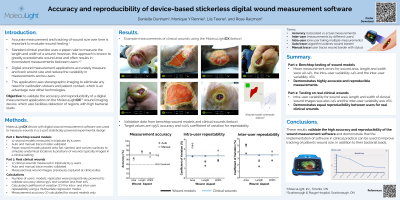Clinical Research
(CR-018) Accuracy and reproducibility of a device based stereoscopic (stickerless) digital wound measurement software
Friday, April 28, 2023
7:15 PM - 8:30 PM East Coast USA Time

Monique Rennie, PhD – MolecuLight, Inc.; Nikola Andric, MEng – MolecuLight, Inc.; Liis Teene, MSc – MolecuLight, Inc.; Rose Raizman, RN-EC, MSc – Scarborough & Rouge Hospital
Introduction: Accurate measurement and tracking of wound size over time is important to evaluate wound healing. The standard practice approach of using a ruler frequently overestimates wound area and can be inconsistent between users. Digital wound measurement applications increase measurement accuracy and reduce inter-user variability. Most require the use of calibration stickers; these hinder workflows and require patient contact with the sticker material. We tested the accuracy and reproducibility of a digital measurement application on a wound imaging device* that leverages stereoscopic imaging and advanced algorithms to eliminate the need for calibration stickers. This device also captures fluorescence images of wounds to map bacterial hotspots (elevated bacterial loads at >104 CFU/g).
Methods: A two-part, statistically powered validation of the wound measurement software including benchtop wound models and clinical wound images. Part 1: 17 wound models including flat, sloped, and convex surfaces were imaged and measured 3 times by 5 clinical users to validate the absolute accuracy and inter/intra-user variability in wound measurements. Part 2: 17 clinical wound images were measured 3 times by 5 clinicians to assess inter/intra-user variability on real wounds where the delineation of wound borders is often more subjective than wound models.
Results: Part 1: < 4% mean measurement errors for wound area, length, and width; < 4% intra-user variability, and < 6% inter-user variability in benchtop wound models – this demonstrates highly accurate and reproducible measurements. Part 2: < 4% intra-user variability and < 6% inter-user variability in real wounds – demonstrates that the wound measurement software is equally reproducible between users for real clinical wounds.
Discussion: These results validate the accuracy and reproducibility of the wound measurement software and demonstrate that the implementation of software in clinical practice can be used to improve tracking of patients wound size, in addition to their bacterial loads.
Methods: A two-part, statistically powered validation of the wound measurement software including benchtop wound models and clinical wound images. Part 1: 17 wound models including flat, sloped, and convex surfaces were imaged and measured 3 times by 5 clinical users to validate the absolute accuracy and inter/intra-user variability in wound measurements. Part 2: 17 clinical wound images were measured 3 times by 5 clinicians to assess inter/intra-user variability on real wounds where the delineation of wound borders is often more subjective than wound models.
Results: Part 1: < 4% mean measurement errors for wound area, length, and width; < 4% intra-user variability, and < 6% inter-user variability in benchtop wound models – this demonstrates highly accurate and reproducible measurements. Part 2: < 4% intra-user variability and < 6% inter-user variability in real wounds – demonstrates that the wound measurement software is equally reproducible between users for real clinical wounds.
Discussion: These results validate the accuracy and reproducibility of the wound measurement software and demonstrate that the implementation of software in clinical practice can be used to improve tracking of patients wound size, in addition to their bacterial loads.

.png)